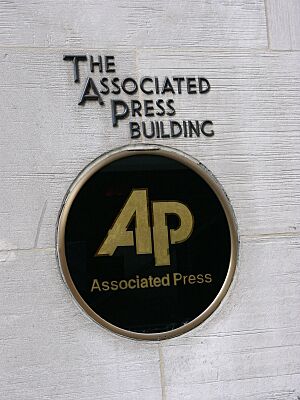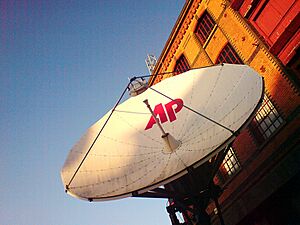Associated Press facts for kids
 |
|
| Not-for-profit cooperative | |
| Industry | News media |
| Founded | May 22, 1846 |
| Headquarters |
200 Liberty Street, New York City, U.S.
|
|
Area served
|
Worldwide |
|
Key people
|
|
| Products | Wire service |
| Revenue | |
|
Number of employees
|
3,300 |
The Associated Press (AP) is a major American news organization. It is a not-for-profit group that works like a cooperative. This means its members, like newspapers and TV stations, own and guide it. The AP is based in New York City.
Founded in 1846, the AP gathers and shares news from all over the world. Its news reports go to many newspapers, radio stations, and TV channels. The AP has won many Pulitzer Prizes for its excellent journalism, including many for photography. It also creates the AP Stylebook, which is a guide for writing news. The AP also runs polls for NCAA sports and reports election results.
By 2016, over 1,300 newspapers and broadcasters used news from the AP. The AP has offices in 94 countries and publishes news in English, Spanish, and Arabic. It also has the AP Radio Network, which provides news and sports updates. Many news groups outside the U.S. pay to use AP news.
Contents
The AP's Story
The Associated Press started in May 1846. Five daily newspapers in New York City joined together. They wanted to share the cost of getting news about the Mexican–American War. This made it cheaper and faster for them all.
At first, it was called the New York Associated Press (NYAP). Other news groups, like the Western Associated Press, thought NYAP was too powerful. An investigation in 1892 showed that NYAP had secret deals with a rival group. This led to the end of NYAP. In December 1892, the Western Associated Press became the new Associated Press.
In 1900, a court decision made the AP move from Chicago to New York City. This was because laws in New York were better for cooperatives.
Melville Stone led the AP from 1893 to 1921. He helped it grow into a major news agency. Later, Kent Cooper, who led from 1925 to 1948, expanded AP's offices around the world.
In 1935, the AP started Wirephoto. This was a new way to send news photos over phone lines very quickly. It gave the AP a big advantage. The first Wirephoto network connected New York, Chicago, and San Francisco. Soon, it covered the whole United States.
In 1941, the AP began sending news to radio stations. In 1974, it started its own radio network. The AP also created APTV in 1994, which gathers video news globally. APTV later merged to form APTN. APTN provides video to TV stations and websites worldwide.
In 1945, the Supreme Court of the United States ruled that the AP could not stop its member newspapers from sharing news with non-members. It also could not make it hard for new newspapers to join.
The AP has changed how it gets its money. In 2007, only about 30% of its money came from U.S. newspapers. By 2024, this was only 10%. More money now comes from global TV customers, online projects, and international newspapers.
In March 2024, some large U.S. newspaper companies, like Gannett and McClatchy, decided to stop using some AP content. However, they still use AP's election results.
Online News and Non-Profit Work
The AP's news articles are often seen on big websites like Yahoo! and MSN. These sites often use AP as their first source for breaking news. This shows how important AP is for getting news out quickly.
In 2007, Google started paying to get AP content for Google News. A study in 2017 showed that AP content was very popular on Facebook.
In June 2024, the AP announced it would start a new non-profit group. This group aims to expand local news coverage.
Important Moments in AP History
- 1849: The first AP news office outside the U.S. opened in Halifax, Canada. It met ships from Europe to get news early.
- 1876: Mark Kellogg was the first AP reporter killed while reporting news. This happened at the Battle of the Little Bighorn.
- 1899: The AP used Guglielmo Marconi's wireless telegraph to cover a yacht race. This was the first news test of this new technology.
- 1914: The AP started using teleprinters. These machines sent news directly to printers over telegraph wires.
- 1935: The AP launched WirePhoto, the first service to send photos over wires.
- 1941: The AP began sending news to radio stations.
- 1943: Ruth Cowan Nash became the first American woman war correspondent for the AP.
- 1945: AP reporter Joseph Morton was killed while reporting during World War II.
- 1974: The AP started its own radio network.
- 1994: The AP launched APTV, a global video news agency.
- 2004: The AP moved its main office to a new building in New York City.
- 2008: The AP launched AP Mobile, an app for news on phones. It was one of the first apps for the iPhone.
- 2012: Gary B. Pruitt became the new president and CEO of the AP.
- 2017: The AP moved its headquarters again to 200 Liberty Street, New York City.
- 2018: The AP started using AP Votecast to replace exit polls for U.S. elections.
How the AP is Run
The AP is guided by a group of people called the board of directors. These people are elected. Since April 2022, Gracia C. Martore has been the chairperson.
Reporting Challenges
The AP has over 100 offices around the world. This means it reports from many countries, even those where news reporting is difficult.
Reporting in the United States
In February 2025, the AP faced restrictions on reporting from the White House. Two AP reporters were not allowed to cover events. This happened because the AP did not use a specific term for the Gulf of Mexico as requested by the White House. The AP sued the Trump administration over these restrictions.
On April 8, 2025, a judge ruled that the White House must allow the AP to access events again. The judge said the lawsuit would continue.
Election Reporting
The AP is one of the main groups that collects and checks election results in the United States. This includes races for president, Congress, and governors. The AP has collected presidential election data since 1848. Many news groups wait for the AP's results before announcing winners.
The AP uses a large network of local reporters. These reporters know their areas well and work with local officials. The AP also checks county websites and state data. Its research team looks at other details like population and absentee ballots. In 2018, the AP started AP VoteCast. This new system helps make its election data even more reliable.
Sports Rankings
The AP creates rankings for many college sports teams in the United States.
College Football Poll
The AP college football rankings started in 1936. Since 1989, they have included the top 25 teams. The final poll of each season is released after all bowl games. As of 2017, 22 different teams had been ranked number one. Before bowl games decided the national champion, the AP poll often helped decide who was the best team.
College Basketball Poll
The AP college basketball poll helps show which teams are getting national attention. It started in 1949. The poll began with 20 teams, then went to 10, and then back to 20. Since 1989–90, it has included 25 teams. The final poll for each season comes out before the NCAA tournament. In 2017, the AP listed the Top 100 teams of all time.
Sports Awards
The AP gives out several awards in sports.
Baseball Awards
The AP gave out a Major League Baseball Manager of the Year Award from 1959 to 2000.
Basketball Awards
Each year, the AP announces the winners of its AP College Basketball Player of the Year and AP College Basketball Coach of the Year awards. It also names a group of All-American players.
Football Awards
The AP gives out many awards for professional and college football:
- AP NFL Most Valuable Player
- AP NFL Offensive Player of the Year
- AP NFL Defensive Player of the Year
- AP NFL Offensive Rookie of the Year
- AP NFL Defensive Rookie of the Year
- AP NFL Coach of the Year
- AP NFL Comeback Player of the Year
- AP College Football Player of the Year
Associated Press Television News
APTN was started in 1994 in London. It provides news videos to TV broadcasters. In 1998, the AP bought Worldwide Television News. As of 2016, the AP publishes 70,000 videos and 6,000 hours of live video each year. It also offers live video channels for broadcasters and online publishers. The AP was the first news agency to launch a live video news service in 2003.
AP Stylebook
The AP Stylebook is a writing guide used by many journalists and news organizations. It helps make sure news reports are clear, consistent, and easy to understand. It covers rules for grammar, spelling, punctuation, and how to write about different topics.
Awards and Recognition
The AP has won 59 Pulitzer Prizes. This includes 36 awards for photography. In May 2020, three AP photographers, Dar Yasin, Mukhtar Khan, and Channi Anand, won the 2020 Pulitzer Prize for Feature Photography.
In 2024, the AP won an Oscar for the documentary film 20 Days in Mariupol. This film showed the early days of Russia's invasion of Ukraine in 2022.
See also
 In Spanish: Associated Press para niños
In Spanish: Associated Press para niños
- Agence France-Presse, a French news agency
- AP Stylebook
- Australian Associated Press, an Australian news agency
- The Canadian Press, a Canadian news agency
- EFE, a Spanish news agency
- List of news agencies
- Reuters
- TweenTribune, a news site for children



